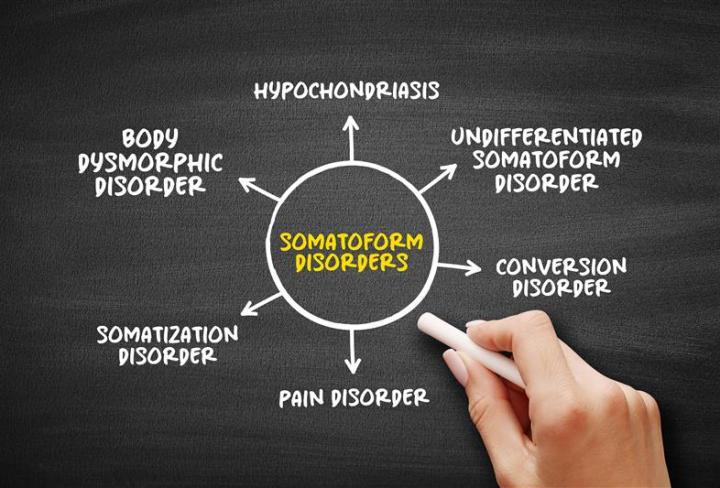Somatoform disorder is a condition where psychological stress results in physical symptoms that often have no medical explanation. People who suffer from this disorder experience real discomfort, even if there isn’t a clear physical source. Understanding and managing somatoform disorder effectively is crucial for the well-being of those affected and their families. Recognizing symptoms early and seeking appropriate treatment can lead to significant improvements in quality of life. This comprehensive guide will delve into the symptoms, causes, and effective treatments available for this complex disorder, providing crucial insights for those seeking help and support.
Somatoform Disorder: An Overview
Somatoform disorder occurs when mental distress manifests as physical symptoms. The symptoms of somatoform disorder are real and can significantly impact daily life. People might think these symptoms are imaginary, but that’s not true. The pain and discomfort are genuine, even if hard to explain medically. Understanding the link between mind and body in somatoform disorder is essential. This disorder is featured in the DSM-5, which helps healthcare professionals assess and diagnose it accurately. This information underscores the importance of acknowledging the disorder as a real challenge that needs attention and care.
Identifying Common Symptoms
Symptoms of somatoform disorder often include unexplained pain, neurological issues, and fatigue. These physical manifestations can be accompanied by emotional responses such as anxiety and depression. Individuals with this disorder may also exhibit behavioral changes. Things like avoidance of activities they once enjoyed can be a red flag. Different types of somatoform disorders might have varying symptoms, but all are deeply distressing. Traumatic events can exacerbate symptoms, making it crucial to address any psychological wounds. Identifying these common symptoms helps in understanding the depth of somatoform disorder’s impact and opens pathways for seeking timely treatments.
Risk Factors and Prevalence
Somatoform disorder is more prevalent in women than men, often starting in younger age groups. These factors highlight the need for early attention. People with somatoform disorder frequently face co-morbid conditions with somatoform disorder, such as depression and anxiety. Understanding these associations can guide clinicians in providing better, more holistic care. Awareness of these risk factors can help loved ones recognize signs early and seek help, thus managing the disorder effectively.
Unveiling Causes and Risk Factors
The exact causes of somatoform disorder are largely unknown, but psychological and environmental factors might play a role. It is essential for healthcare providers to rule out medical causes first to avoid misdiagnosis. Stressful life events and familial tendencies can contribute to the development of the disorder. These elements complicate the understanding of somatoform disorder but also highlight areas for focused research. By recognizing potential risk factors, individuals and healthcare providers can work together to find effective management solutions.
Impact on Daily Living
The impact of somatoform disorder on daily life can be profound. It affects personal relationships, work, and social activities, leading to significant functional impairment. Those affected might face misunderstanding and stigma, adding emotional distress. Financial burdens also come into play due to frequent medical appointments. For families, the journey involves offering consistent support and understanding. The disorder’s impact is not limited to physical health; it reaches into every corner of daily living, making comprehensive care and support systems essential.
Diagnosis and Challenges Faced
Somatoform disorder diagnosis criteria include persistent symptoms that affect daily functioning. Diagnosing the disorder can be challenging due to overlapping symptoms with other conditions. The journey to diagnosis often involves ruling out other medical issues through extensive testing, which can be a lengthy and frustrating process for patients and families. Because of this complexity, healthcare professionals must be thorough to ensure an accurate diagnosis, which paves the way for appropriate treatment strategies.
Treatment and Management Strategies
Treatment for somatoform disorder aims to relieve symptoms and improve quality of life. Psychotherapy for somatoform disorder is a central treatment option, focusing on addressing psychological issues. Cognitive-behavioral therapy (CBT) often proves beneficial, helping patients develop coping mechanisms. Medication may also be used, though mainly to manage co-morbid conditions with somatoform disorder like depression. A holistic approach incorporating lifestyle changes such as regular exercise and stress reduction techniques is helpful. By combining these strategies, patients have the best chance at managing symptoms effectively. Encouraging patient involvement in treatment planning boosts success and empowers them in their recovery journey.
Living with Somatoform Disorder: Community and Family Support
Community and family support play a crucial role in coping with somatoform disorder. Families can aid recovery by being empathetic and patient. Providing stability and encouragement helps build a supportive environment. It’s also beneficial for affected individuals to engage in support groups, where they can share experiences and learn new coping techniques. Practical advice includes maintaining open communication and setting realistic goals for daily achievements. Through these supportive networks, those with somatoform disorder can navigate their challenges more effectively.


